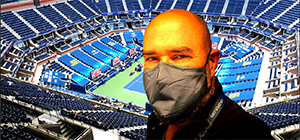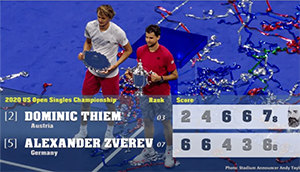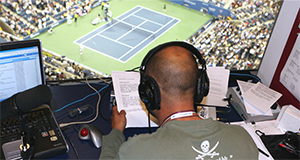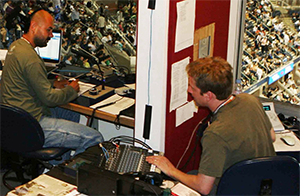VIEW AND DOWNLOAD WORLD TENNIS GAZETTE VOL. 13 NO. 5
By JOHN MARTIN

credit: John Martin
On the last day of August, Stadium Announcer Andy Taylor (andytayloronline.com) leaned forward from his desk in Room 6314 of Arthur Ashe Stadium in Flushing, N.Y. and glanced downward into an empty canyon.
There were no spectators. This was a coronavirus health precaution, the infamous bubble the world was creating around its prized locations.
Taylor is one of the globe’s four most prized tennis announcers who introduce matches at the world’s four most prized championships, Australia, Roland Garros, Wimbledon, and the United States.
In Flushing, Taylor took up his task: Introducing dozens of players as they fought their way from first round to finals through 44 U.S. Open matches on America’s equivalent of Wimbledon’s Centre Court.
From inside a small, 8X14-foot room he had requested atop the stadium, Taylor’s voice could be heard on television around the world as he identified and discussed players arriving and departing the stadium stage.
Over the next two weeks, Taylor took notes and wrote summaries of each match for a notebook he creates to track players from round to round and year to year.
Blessed with a rich, silky voice, Taylor showed a skillful hand at critical analysis. He composed some remarkably stern observations.

credit: John Martin
One example. “Reality check,” Taylor wrote of the men’s final between Dominic Thiem of Austria and Alexander Zverev of Germany.
“This was not an entertaining championship tennis match,” Taylor wrote. “While there was drama — that drama was rooted in miscues. The match was tentative. Heavy on mistakes. Unforced errors. Enormous misses. Undeniable nerves. Occasional moments of gutsy payoff. But mostly replete with sorrow for each player’s dependance on the other’s anxious blunders. It was tough on the eyes.”
Taylor also kept his eyes on social and political issues in addition to athletic achievements. Besides reporting the pandemic’s seven-month interruption between the Australian and United States Opens, Taylor explained for future sports historians that this year’s event was carried on at a time of “extreme social unrest in the United States.”
“Naomi Osaka captured her third major and second US Open title while intently raising awareness of American racial injustice.
“Before all seven victories,” Taylor reported, “Osaka entered Arthur Ashe Stadium wearing cloth face masks emblazoned with names of people of color who were victims of police brutality.”
“Nothing has felt normal since March,” Taylor told me in mid-October.

credit: Andy Taylor
In his 19 years as the Voice of the U.S. Open, Taylor, 46, has created a professional career that carries him around the globe as the voice of authority, compassion, and enthusiasm.
“It’s businesses all over the world,” he explained in a telephone interview from Somerville, MA. The projects require English voice-over recordings ordered for a robotics company in New England, a tools company in Germany, and a food delivery company in British Columbia, among others.
Not surprisingly, some of his labors take him to the fringes of sport.
“I do remote announcing, I’m the announcer of a martial art in Myanmar called Lethwei,” Taylor said.
“The form is called the art of nine limbs. It’s the purest form of fighting I’ve ever seen,” he said. The Lethwei assignment of voice over has a second element, Taylor explained.
“I am the announcer that brings the fighters out to the arena or welcomes the fans to the arena, and that’s a totally different character,” Taylor said.
“That’s where I’m almost screaming and like I’m an insane man just going crazy in the voice-over booth.”
Avoiding the Coronavirus has introduced an element of even greater uncertainties into the sports Taylor announces. The danger has taken a large chunk out of the world’s attempt to conduct business as usual.
“I was supposed to host the Qatar Classic,” in January, Taylor said. Instead, this month (October), he suspended all international travel. In a thoughtful public statement embracing responsibility for not spreading the Covid-19 virus, Taylor announced he would remain at work in his home and studio outside Boston.
“I’ll reassess in mid-December,” he said. With the United States “as the global leader in Coronavirus cases, it would be tremendously arrogant and irresponsible of me to get on an international flight and go to another country and potentially get these athletes and colleagues sick.”
So what was it like announcing to an empty stadium?
“You’re used to accentuating the excitement,” Taylor explained, noting the stark differences between day and night. As a result, he said, “The atmosphere was completely gone.”
Anyone listening coud hear a stark difference from its usual bubbly quality. Instead of brimming with excitement, his voice sounded toned down, calm. There was a reason.

credit: Andy Taylor
“You cannot present this like you would be announcing Roger Federer. It has to be more matter of fact, like you’re just presenting information to them…so they can have a sense of what’s at stake in the match they’re about to watch.”
Taylor sings praise for the effort expended by the USTA to create and secure the bubble for action-starved fans around the world.
“It’s a wonderful opportunity for people to finally see live sport and escape the fear and the anxiety that we’ve been living since February when we heard the numbers coming out from China.”
With so much turmoil spilling across the world this year — a cancelled Tokyo Olympics, an American Presidential Election among them — Taylor’s unusual actions at the 2020 U.S. Open might be overlooked. They should be remembered.
Asked to work in a masked group in New York rather than his preference — contribute voice overs remotely from his home studio outside Boston — Taylor won permission to write his own work plan.
“I realized how incredibly lucky I was,” he said, sympathizing with his many unemployed fellow announcers in the entertainment industry. He was thankful, too, for being allowed to build what he called “my own bubble within the bubble of the U.S. Open.”
Here’s the way he did it: Instead of boarding a crowded airplane to fly to New York from Boston, Taylor packed his own vehicle with cleaning supplies, extra sanitizer, a cooking plate and plenty of groceries. He drove 202 miles directly to the Billie Jean King National Tennis Center just off the Grand Central Parkway on Long Island.
“So I just hauled all that stuff up to the booth two days before the event started,” he said.
What followed was a ritual aimed at keeping himself and his fellow workers uninfected. His vows:
“I will not talk to anybody. I’m going to keep my mask on. I’m just going to go from the hotel to my booth, and then I’m going to stay in the booth until everybody’s out of the building, and then I’m going to go back to the hotel.”
Finally, what was the hardest part of announcing this year’s spectatorless U.S. Open?
“Just not engaging with fans,” said Taylor, “the hard part was accepting that.”